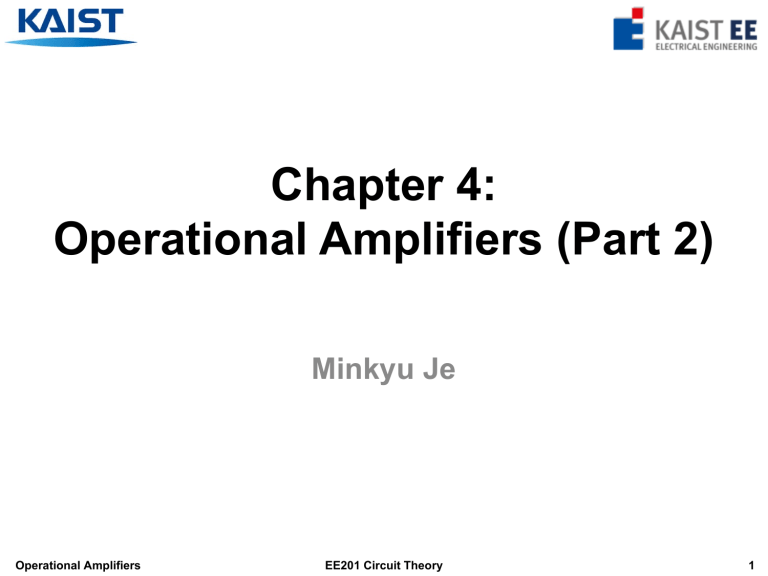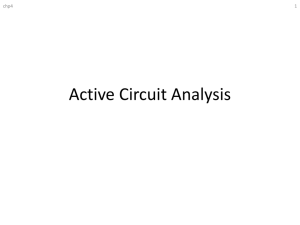
Chapter 4: Operational Amplifiers (Part 2) Minkyu Je Operational Amplifiers EE201 Circuit Theory 1 Outline ¢ Introduction ¢ Op-Amp Models ¢ Fundamental Op-Amp Circuits Operational Amplifiers EE201 Circuit Theory 2 Inverting Amplifier ¢ Nonideal op-amp model Op-amp v1 - vS v1 v1 - vo + + =0 R1 Ri R2 v o - v 1 v o - Av e + =0 R2 Ro v e = -v 1 Operational Amplifiers EE201 Circuit Theory 3 Inverting Amplifier ¢ Nonideal op-amp model é1 1 1 + + ê ê R1 Ri R2 ê æ 1 Aö ç ÷÷ ê çR ë è 2 Ro ø v1 - vS v1 v1 - vo + + =0 R1 Ri R2 v o - v 1 v o - Av e + =0 R2 Ro v e = -v 1 £ vo = vS æ 1 öù ÷÷ ú - çç év S ù v é ù R è 2ø ú 1 =ê ú R 1 1 ú êëv o úû ê 01 ú + ë û R2 Ro úû - (R2 R1 ) éæ 1 1 1 öæ 1 1 ö ÷÷ ÷÷çç 1 - êçç + + + ëè R1 Ri R2 øè R2 Ro ø æ 1 öæ 1 A öù ÷÷ ú çç ÷÷çç è R2 øè R2 Ro ø û Employing typical values for the circuit parameters (e.g., A = 105, Ri = 108 W, Ro = 10 W, R1 = 1 kW, and R2 = 5 kW), vo = -4.9996994 » -5.0000 . vS £ For the ideal op-amp model, æv ö R lim çç o ÷÷ = - 2 = -5 . A ® ¥è v S ø R1 Operational Amplifiers EE201 Circuit Theory 4 Inverting Amplifier ¢ Ideal op-amp model i+ = i- = 0 v+ = v£ £ Since v+ = 0, v- = 0. £ The gain is a simple resistor ratio. 0 - vS 0 - vo + =0 R1 R2 £ The gain is essentially independent of op-amp parameters. For the ideal op-amp model, £ Despite the op-amp parameters Ao, Ri, and Ro that are sensitive to fabrication tolerance, temperature, and supply voltage, the gain is stable. vo R =- 2. vS R1 Operational Amplifiers EE201 Circuit Theory 5 Noninverting Amplifier ¢ Ideal op-amp model £ Employing the ideal op-amp model conditions, v - = v + = v in and i - = 0 . £ The KCL equation at the negative terminal of the op-amp is v in v o - v in or = RI RF æ 1 1 ö vo ÷÷ = v in çç + . R R R è I F ø F £ Thus, vo R = 1+ F . v in RI Operational Amplifiers EE201 Circuit Theory 6 Gain Error ¢ Gain error in an amplifier is defined as é actual gain - ideal gain ù GE = ê ú ´ 100%. ideal gain ë û £ For a standard noninverting configuration with finite gain Ao, v S = v in + v 1, v o = Aov in , and v 1 = £ Solving these equations, vS = £ R1 vo º b vo . R1 + R2 é 1 + Ao b ù 1 vo + b vo = vo ê ú. Ao A ë û o Thus, the actual gain is vo Ao = . v S 1 + Ao b Operational Amplifiers EE201 Circuit Theory 7 Gain Error ¢ Gain error in an amplifier is defined as é actual gain - ideal gain ù GE = ê ú ´ 100%. ideal gain ë û £ Recalling that the ideal gain is (R1 + R2)/R1 = 1/b, the gain error is 1ù é Ao ê 1+ A b b ú - 100% o GE = ê . ú ´ 100% = 1 1 + A b ê ú o êë úû b Operational Amplifiers EE201 Circuit Theory 8 Difference Amplifier ¢ Ideal op-amp model £ For the ideal op-amp model, v - = v + = v in and i - = i + = 0. £ At the inverting terminal, v1 - v - vo - v + = 0. R1 R2 £ At the noninverting terminal, v2 - v - v = . R3 R4 £ Solving these two equations for vo results in the expression vo = £ R2 æ R ö R4 R çç 1 + 1 ÷÷ v 2 - 2 v1 . R1 è R2 ø R3 + R4 R1 Note that if R4 = R2 and R3 = R1, the expression reduces to v o = Operational Amplifiers EE201 Circuit Theory R2 (v 2 - v 1) . R1 9 Summing Amplifier ¢ Ideal op-amp model £ Applying KCL at node a, I = I1 + I2 + I3 , where I1 = £ V1 - Va V - Va V - Va V - Vo , I2 = 2 , I3 = 3 , and I = a . R1 R2 R3 Rf Solving these equations together for vo, æR ö R R Vo = -çç f V1 + f V2 + f V3 ÷÷ . R2 R3 ø è R1 Operational Amplifiers EE201 Circuit Theory 10 Precision Diff. Voltage-Gain Amp. ¢ It is used to provide a singeended input for an analog-todigital converter. £ Since we are interested in an expression for vo in terms of v1 and v2, we eliminate va terms from the following two node equations: v1 - vo v1 - v a v1 - v 2 + + =0 R2 R1 RG v 2 - v a v 2 - v1 v 2 + + = 0. R1 RG R2 £ Therefore, æ R 2R2 ö ÷÷ . v o = (v 1 - v 2 )çç 1 + 2 + R R è 1 G ø Operational Amplifiers EE201 Circuit Theory 11 Electronic Ammeter ¢ The unknown current, I, through RI produces a voltage, VI . VI is amplified by the op-amp to produce a voltage, Vo, which is proportional to I. The output voltage is measured with a simple voltmeter. We want to find the value of R2 such that 10 V appears at Vo for each milliamp of unknown current. æ R ö VI = IRI and Vo = VI çç 1 + 2 ÷÷ R1 ø è æ Vo R ö 10 V = RI çç 1 + 2 ÷÷ = , resulting in R2 = 9 kW . I R 1 mA è 1ø Operational Amplifiers EE201 Circuit Theory 12 Two-Stage Amplifier ¢ The circuit consists of two noninverting amplifier. £ Output of the first amplifier: 12k ö æ Va = 20m ´ ç 1 + ÷ = 100 mV 3 k è ø £ Output of the second amplifier: 10k ö æ Vo = 100m ´ ç 1 + ÷ = 350 mV 4k ø è £ Io through 10-kW resistor: Io = Vo - Vb 350m - 100m = = 25 μA 10k 10k Operational Amplifiers EE201 Circuit Theory 13 Output Voltage Range ¢ The two op-amp circuits shown in the figure produce an output given by Vo = 8V1 - 4V2 where 1 V £ V1 £ 2 V and 2 V £ V2 £ 3 V. Determine (a) the range of Vo and (b) if both of the circuits will produce the full range of Vo given that the dc supplies are ±10 V. Circuit 1 £ Circuit 2 Range of Vo : Vo,min = 8V1,min - 4V2,max = 8 ´ 1 - 4 ´ 3 = -4 V. Vo,max = 8V1,max - 4V2,min = 8 ´ 2 - 4 ´ 2 = 8 V. Operational Amplifiers EE201 Circuit Theory 14 Output Voltage Range ¢ The two op-amp circuits shown in the figure produce an output given by Vo = 8V1 - 4V2 where 1 V £ V1 £ 2 V and 2 V £ V2 £ 3 V. Determine (a) the range of Vo and (b) if both of the circuits will produce the full range of Vo given that the dc supplies are ±10 V. £ Vx is given by Vx = 2V1 - V2 . £ Range of Vx: Vx,min = 2V1,min - V2,max = 2 ´ 1 - 3 = -1 V. Vx,max = 2V1,max - V2,min = 2 ´ 2 - 2 = 2 V. £ Circuit 1 Operational Amplifiers Since both the max and min values are within the supply range, the first op-amp will not saturate, and this circuit will produce the full range of Vo. EE201 Circuit Theory 15 Output Voltage Range ¢ The two op-amp circuits shown in the figure produce an output given by Vo = 8V1 - 4V2 where 1 V £ V1 £ 2 V and 2 V £ V2 £ 3 V. Determine (a) the range of Vo and (b) if both of the circuits will produce the full range of Vo given that the dc supplies are ±10 V. £ Vy is given by Vy = -8V1. £ Range of Vy: Vy,min = -8V1,max = -8 ´ 2 = -16 V. Vy,max = -8V1,min = -8 ´ 1 = -8 V. £ Circuit 2 Since the range of Vy is outside the power supply limits, this circuit will saturate and fail to produce the full range of Vo. Operational Amplifiers EE201 Circuit Theory 16 Instrumentation Amplifier ¢ An instrumentation amplifier is an amplifier of low level signals used in process control or measurement applications, and commercially available in single-package units. £ The 2nd-stage amplifier is a difference amplifier, so R Vo = 2 (Vo 2 - Vo1) . R1 £ Since the inverting inputs of A1 and A2 draw no current, I flows through the resistors as if they were in series. Hence, Vo1 - Vo2 = I (2R3 + R4 ) and I= £ Va - Vb V1 - V2 = . R4 R4 As a result, Vo = Operational Amplifiers 2R3 ö R2 æ çç 1 + ÷(V - V1) . R1 è R4 ÷ø 2 EE201 Circuit Theory 17 Negative Feedback ¢ We can note one common characteristic of all circuits studied in this chapter. £ The output is connected to the inverting input of the op-amp through a resistive network. £ This connection where a portion of the output voltage is fed back to the inverting input is referred to as negative feedback. £ Feeding back the output voltage to the negative input terminal maintains this voltage difference near zero to allow linear operation of the op-amp. £ The negative feedback is necessary for the proper operation of nearly all opamp circuits. £ Our analysis of op-amp circuit is based on the assumption that the voltage difference at the input terminals is nearly zero. £ Almost all op-amp circuits utilize negative feedback. Operational Amplifiers EE201 Circuit Theory 18 Negative Feedback ¢ The positive feedback is utilized in oscillator circuits, Schmitt triggers, and comparators. £ The circuit shown below looks similar to the inverting amplifier. £ However, there is one very important difference: R2 is connected to the positive input terminal instead of the negative one, resulting in positive feedback. £ As a result of positive feedback, the output value of this op-amp circuit has two possible values, VCC or VEE . £ Analysis of this circuit using the ideal op-amp model does not predict this result. £ Note that the ideal op-amp model may only be utilized when negative feedback is present in the op-amp circuits. Operational Amplifiers EE201 Circuit Theory 19 Summary ¢ Fundamental op-amp circuits £ Inverting amplifier £ Noninverting amplifier £ Gain error £ Difference amplifier £ Summing amplifier £ Precision differential voltage-gain amplifier £ Electronic ammeter £ Two-stage amplifier £ Output voltage £ Instrumentation amplifier £ Negative feedback Operational Amplifiers EE201 Circuit Theory 20 End of Slides Operational Amplifiers EE201 Circuit Theory 21


